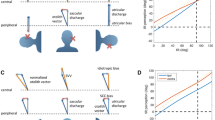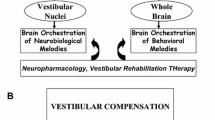Abstract
Vestibular compensation is simulated as learning in a dynamic neural network model of the horizontal vestibulo-ocular reflex (VOR). The bilateral, three-layered VOR model consists of nonlinear units representing horizontal canal afferents, vestibular nuclei (VN) neurons and eye muscle motoneurons. Dynamic processing takes place via commissural connections that link the VN bilaterally. The intact network is trained, using recurrent back-propagation, to produce the VOR with velocity storage integration. Compensation is simulated by removing vestibular afferent input from one side and retraining the network. The time course of simulated compensation matches that observed experimentally. The behavior of model VN neurons in the compensated network also matches real data, but only if connections at the motoneurons, as well as at the VN, are allowed to be plastic. The dynamic properties of real VN neurons in compensated and normal animals are found to differ when tested with sinusoidal but not with step stimuli. The model reproduces these conflicting data, and suggests that the disagreement may be due to VN neuron nonlinearity.
Similar content being viewed by others
Abbreviations
- AC:
-
acutely lesioned network, before compensation
- GR:
-
gain restored, compensating network
- lb :
-
left bias (left non-vestibular input unit)
- lhc :
-
left horizontal canal afferent (left input unit)
- lr :
-
lateral rectus motoneuron (left output unit)
- lvn 1, 2 :
-
left vestibular nuclei neurons (left hidden units)
- mr :
-
medial rectus motoneuron (right output unit)
- NE:
-
nystagmus eliminated, compensating network
- NM:
-
normal network, intact and fully trained
- pass, one:
-
input/desired-output training sequence presentation
- rb :
-
right bias (right nonvestibular input unit)
- rhc :
-
right horizontal canal afferent (right input unit)
- rvn 1, 2 :
-
right vestibular nuclei neurons (right hidden units)
- SR:
-
spontaneous rate
- tick:
-
one time step of network processing (one cycle)
- VOR:
-
vestibulo-ocular reflex
- VN:
-
vestibular nuclei
References
Anastasio TJ (1991) Neural network models of velocity storage in the horizontal vestibulo-ocular reflex. Biol Cybern 64:187–196
Blair SM, Gavin M (1981) Brainstem commissures and control of time constant of vestibular nystagmus. Acta Otolaryngol 91:1–8
Buttner U, Waespe W (1981) Vestibular nerve activity in the alert monkey during vestibular and optokinetic nystagmus. Exp Brain Res 41:310–315
Buttner-Ennever JA (1988) Neuroanatomy of the oculomotor system. Elsevier, Amsterdam
Ezure K, Schor RH, Yoshida K (1978) The response of horizontal semicircular canal afferents to sinusoidal rotation in cat. Exp Brain Res 33:27–39
Fetter M, Zee DS (1988) Recovery from unilateral labyrinthectomy in rhesus monkey. J Neurophysiol 59:370–393
Galiana HL, Flohr H, Melvill Jones G (1984) A reevaluation of intervestibular nuclear coupling: its role in vestibular compensation. J Neurophysiol 51:242–259
Hamann K-F, Lannou J (1988) Dynamic characteristics of vestibular nuclear neurons responses to vestibular and optokinetic stimulation during vestibular compensation in the rat. Acta Otolaryngol [Suppl] 455:1–19
Llinas R, Walton K (1979) Vestibular compensation: a distributed property of the central nervous system. In: Asanuma H, Wilson VJ (eds) Integration in the nervous system. Igaku Shoin, Tokyo, pp 145–166
Maioli C, Precht W, Ried S (1983) Short- and long-term modifications of vestibulo-ocular response dynamics following unilateral vestibular nerve lesions in the cat. Exp Brain Res 50:259–274
Newlands SD, Perachio AA (1990a) Compensation of horizontal canal related activity in the medial vestibular nucleus following unilateral labyrinth ablation in the decerabrate gerbil. I. type I neurons. Exp Brain Res 82:359–372
Newlands SD, Perachio AA (1990b) Compensation of horizontal canal related activity in the medial vestibular nucleus following unilateral labyrinth ablation in the decerebrate gerbil. II. type II neurons. Exp Brain Res 82:373–383
Precht W, Shimazu H, Markham CH (1966) A mechanism of central compensation of vestibular function following hemilabyrinthectomy. J Neurophysiol 29:996–1009
Raphan Th, Matsuo V, Cohen B (1979) Velocity storage in the vestibulo-ocular reflex arc (VOR). Exp Brain Res 35:229–248
Ried S, Maioli C, Precht W (1984) Vestibular nuclear neuron activity in chronically hemilabyrinthectomized cats. Acta Otolaryngol 98:1–13
Rumelhard DE, Hinton GE, Williams RJ (1986) Learning internal representations by error propagation. In: Rumelhard DE, McCleland JL, PDP Research Group (eds) Parallel distributed processing: explorations in the microstructure of cognition, vol 1: Foundation. MIT Press, Cambridge, pp 318–362
Schaefer KP, Meyer DL (1974) Compensation of vestibular lesions. In: Kornhuber HH (ed) Handbook of sensory physiology vol. VI/2. Springer, Berlin Heidelberg New York, pp 463–489
Smith PF, Curthoys IS (1988a) Neuronal activity in the contralateral medial vestibular nucleus of the guinea pig following unilateral labyrinthectomy. Brain Res 444: 295–307
Smith PF, Curthoys IS (1988b) Neuronal activity in the ipsilateral medial vestibular nucleus of the guinea pig following unilateral laybrinthectomy. Brain Res 444:308–319
Smith PF, Darlington CL, Curthoys IS (1986) Vestibular compensation without brainstem commissures in the guinea pig. Neurosci Lett 65:209–213
Waespe W, Henn V (1979) The velocity response of vestibular nucleus neurons during vestibular, visual, and combined angular acceleration. Exp Brain Res 37:337–347
Williams RJ, Zipser D (1989) A learning algorithm for continually running fully recurrent neural networks. Neural Comp 1:270–280
Wilson VJ, Melvill Jones G (1979) Mammalian vestibular physiology. Plenum Press, New York
Wolfe JW, Kos CM (1977) Nystagmic responses of the rhesus monkey to rotational stimulation follwing unilateral laybrinthectomy: final report. Trans Am Acad Ophthalmol Otolaryngol 84:38–45
Yagi T, Markham CH (1984) Neural correlates of compensation after hemilabyrinthectomy. Exp Neurol 84:98–108
Author information
Authors and Affiliations
Rights and permissions
About this article
Cite this article
Anastasio, T.J. Simulating vestibular compensation using recurrent back-propagation. Biol. Cybern. 66, 389–397 (1992). https://doi.org/10.1007/BF00197718
Received:
Accepted:
Issue Date:
DOI: https://doi.org/10.1007/BF00197718




